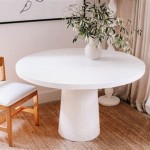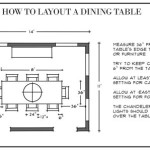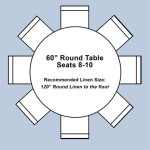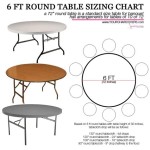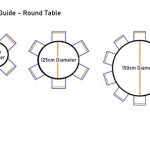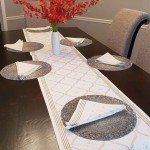DIY Simple Centerpieces for Round Tables
Centerpieces serve as focal points for tables, enhancing the overall aesthetic appeal of an event or gathering. For round tables, the challenge lies in creating designs that complement the circular shape without obstructing conversation or overwhelming the space. DIY centerpieces offer a cost-effective and personalized alternative to professionally designed arrangements. The following article details several simple yet elegant DIY centerpiece ideas suitable for round tables, focusing on accessibility, affordability, and ease of execution.
Floral Focus: Simple Blooms in Neutral Vessels
One of the most classic and versatile centerpiece options involves the strategic use of floral arrangements. The key to simplicity in this context lies in the selection of both the blooms and the vessels used to display them. Opting for a single type of flower, or a limited palette of coordinating flowers, streamlines the design process and creates a unified aesthetic. Neutral vessels, such as clear glass vases, white ceramic pots, or even repurposed tin cans painted in muted tones, provide a sophisticated backdrop without detracting from the beauty of the flowers themselves.
The creation process begins with selecting the appropriate floral materials. Popular choices include roses, hydrangeas, carnations, and baby's breath, all of which are readily available and relatively inexpensive. Consider locally sourced flowers for a more sustainable and potentially more budget-friendly option. When selecting flowers, ensure they are fresh and in good condition, free from blemishes or signs of wilting. A consistent color scheme, such as various shades of a single color or complementary colors from the color wheel, will contribute to a cohesive and elegant look.
Once the floral materials are acquired, the next step involves preparing the vessels. Thoroughly clean any chosen vases or containers to remove dust or fingerprints. If using repurposed materials, ensure they are properly sanitized and free from any sharp edges or hazards. If desired, the vessels can be embellished with simple accents such as ribbons, twine, or paint. The key is to maintain a minimalist approach to avoid overpowering the floral arrangement.
Arranging the flowers involves several techniques to achieve a balanced and visually appealing result. For a single-flower arrangement, trim the stems to the appropriate length, ensuring the blooms sit comfortably within the vessel. A simple round arrangement can be achieved by spiraling the flowers inwards, creating a compact and symmetrical shape. For mixed floral arrangements, consider layering different types of flowers to add depth and visual interest. Use floral foam or a flower frog at the base of the vessel to provide support and structure to the arrangement. Regularly check the water level in the vases and replenish as needed to keep the flowers hydrated and looking their best.
Varying the height of the flower arrangements can add visual interest and prevent them from appearing monotonous. Use a combination of taller and shorter stems to create a dynamic composition. Grouping multiple smaller arrangements together can also be an effective way to fill the space on a round table without creating a single overpowering centerpiece. The number of arrangements will depend on the size of the table, but three to five smaller arrangements generally provide ample coverage without obstructing conversation.
Consider adding greenery to floral arrangements to bring texture and depth to the design. Incorporating elements such as eucalyptus leaves, ferns, or ivy can complement the flowers and add a touch of natural beauty. Greenery also helps to fill in any gaps in the arrangement and create a more lush and full appearance. When selecting greenery, ensure it is fresh and vibrant, free from any signs of browning or damage.
To further enhance the visual appeal of the floral centerpieces, consider adding subtle accents such as candles or decorative stones. Placing votive candles around the base of the arrangements can create a warm and inviting atmosphere. Small stones or pebbles can be added to the bottom of the vases to provide a textural element and anchor the floral stems. The key is to use these accents sparingly to avoid cluttering the design and detracting from the beauty of the flowers themselves.
Candlelight and Reflections: Minimalist Candle Arrangements
Candle arrangements provide an ambiance that is both elegant and intimate, making them an ideal choice for round table centerpieces. Simplicity is paramount in this approach. The emphasis should be on the quality of the candles themselves and the design of the holders, rather than complex decorative elements. A cluster of candles in varying heights and sizes can create a visually appealing and inviting focal point.
Selecting the right candles involves considering several factors. Pillar candles, taper candles, and votive candles each offer unique characteristics and contribute to different aesthetic styles. Pillar candles are a reliable and stable choice, suitable for grouping together or displaying individually. Taper candles add a touch of traditional elegance, particularly when placed in candlestick holders. Votive candles are ideal for creating a soft and diffused glow, especially when arranged in multiples.
The choice of candle holders is equally important in creating a visually appealing centerpiece. Glass holders, metal holders, and wooden holders each offer distinct aesthetic qualities. Clear glass holders allow the candlelight to shine through uninhibited, creating a bright and luminous effect. Metal holders, such as brass or silver, add a touch of sophistication and glamour. Wooden holders offer a rustic and natural feel, complementing a more casual and bohemian style.
Arranging the candles strategically is essential for creating a balanced and visually pleasing composition. Grouping candles of varying heights together can create a dynamic and interesting display. Consider arranging the candles in a circular or triangular pattern to complement the shape of the round table. Placing a mirror underneath the candle arrangement can amplify the candlelight and create a sense of depth and dimension. The mirror should be slightly larger than the perimeter of the candle arrangement to maximize its reflective effect.
To enhance the aesthetic appeal of the candle centerpiece, consider adding subtle decorative elements such as greenery, ribbons, or beads. A simple garland of greenery can be draped around the base of the candles to add a touch of natural beauty. A ribbon tied around the base of a candle holder can add a pop of color and visual interest. Small beads or crystals can be scattered around the candles to catch the light and create a sparkling effect. The key is to use these accents sparingly to avoid overpowering the candle arrangement and detracting from the overall minimalist aesthetic.
When using candles as centerpieces, it is essential to prioritize safety. Ensure the candles are placed on a stable surface, away from flammable materials. Never leave lit candles unattended, and always extinguish them before leaving the room. Consider using battery-operated candles as a safe and convenient alternative to traditional candles, especially in environments where open flames may be a concern.
Natural Elements: Organic and Rustic Centerpieces
Incorporating natural elements into centerpieces offers a cost-effective and visually appealing approach to table decoration. The focus shifts to the inherent beauty of materials found in nature, such as wood, stones, branches, and leaves. These elements can be arranged in a variety of ways to create rustic and organic centerpieces that complement a wide range of event themes.
Gathering natural materials can be a fun and rewarding process. Fallen branches, smooth stones, and interesting leaves can be collected from parks, forests, or even your own backyard. Ensure that any collected materials are clean and free from insects or debris. Dried branches can be sprayed with paint or glitter to add a touch of glamour. Stones can be polished or painted to create a more refined look. Pinecones, acorns, and nuts can also be incorporated into the centerpiece to add texture and visual interest.
Wooden elements can be used in various ways to create rustic and charming centerpieces. Wooden slices or rounds can be used as bases for other decorative elements, such as candles or floral arrangements. Small wooden boxes or crates can be filled with flowers, greenery, or other natural materials. Driftwood can be arranged in unique and sculptural formations to create a visually striking centerpiece. The natural grain and texture of the wood adds warmth and character to the table setting.
Stone elements provide a sense of grounding and stability to the centerpiece design. Smooth river stones can be arranged in a circular pattern around a candle or floral arrangement. Larger stones can be used as pedestals to elevate other decorative elements. Incorporating stones of varying sizes and colors can add depth and visual interest to the centerpiece. The cool and calming nature of the stones provides a counterpoint to the warmer tones of the wood and other natural materials.
Foliage and branches can be used to create a lush and organic centerpiece design. Greenery such as ferns, eucalyptus, and ivy can be arranged in a vase or draped across the table to add a touch of natural beauty. Branches can be arranged in tall vases to create a dramatic and eye-catching centerpiece. Consider using branches with interesting shapes or textures to add visual interest. Seasonal foliage, such as fall leaves or spring blossoms, can be incorporated into the centerpiece to reflect the current time of year.
Accenting the natural elements with subtle details can enhance the overall aesthetic appeal of the centerpiece. Twinkle lights can be woven through branches or draped around stones to create a magical and enchanting atmosphere. Burlap or twine can be used to wrap around wooden elements or tie bundles of greenery together. Small glass jars or bottles can be filled with wildflowers or herbs to add a touch of whimsy. The key is to use these accents sparingly to avoid overpowering the natural beauty of the materials themselves.
When creating natural centerpieces, consider the overall theme and aesthetic of the event. A rustic wedding may call for a more elaborate and textured centerpiece, while a casual dinner party may benefit from a simpler and more understated design. The goal is to create a centerpiece that complements the overall ambiance of the gathering and enhances the dining experience for all attendees.

12 Lovely Ways To Decorate Round Tables Luxury Weddings

Most Stunning Round Table Centerpieces

40 Simple Wedding Centerpieces For The Minimalist
:max_bytes(150000):strip_icc()/round-table-wedding-decor-ideas-dragonfly-photography-49c811012a23428ebe52a4222def3108.jpg?strip=all)
25 Round Table Wedding Décor Ideas Centerpieces Place Settings And More

Simple Centerpieces Are Perfect For Round Tables Weddinginspo

51 Wedding Centerpiece Ideas We Re Swooning Over

40 Simple Wedding Centerpieces For The Minimalist

Diy Rustic Eucalyptus Centerpiece Blooms By The Box

12 Crafty Ideas For Diy Table Centerpieces

Gorgeous Round Table Centerpiece Ideas For Summer Perfecting Places
Related Posts

